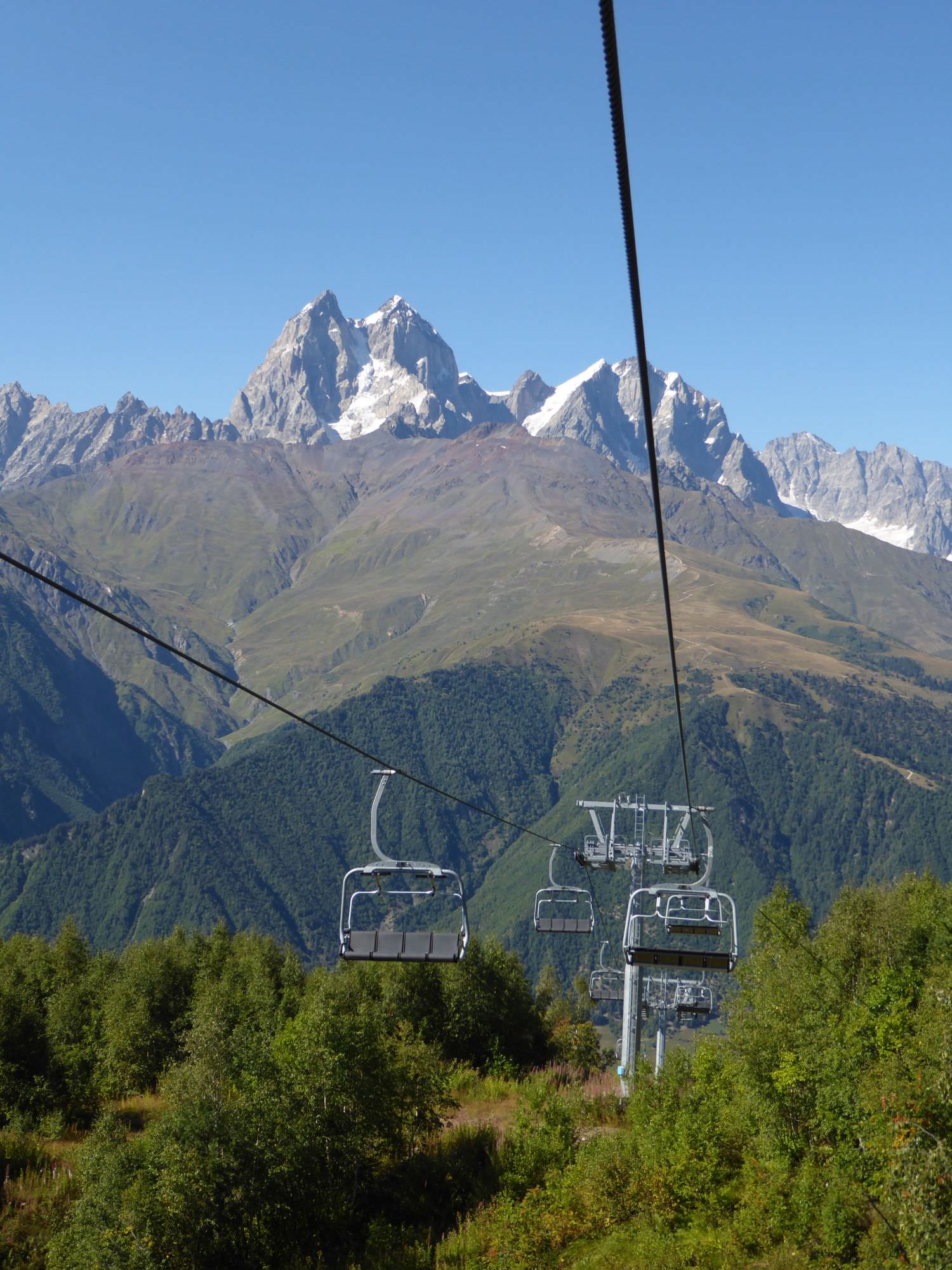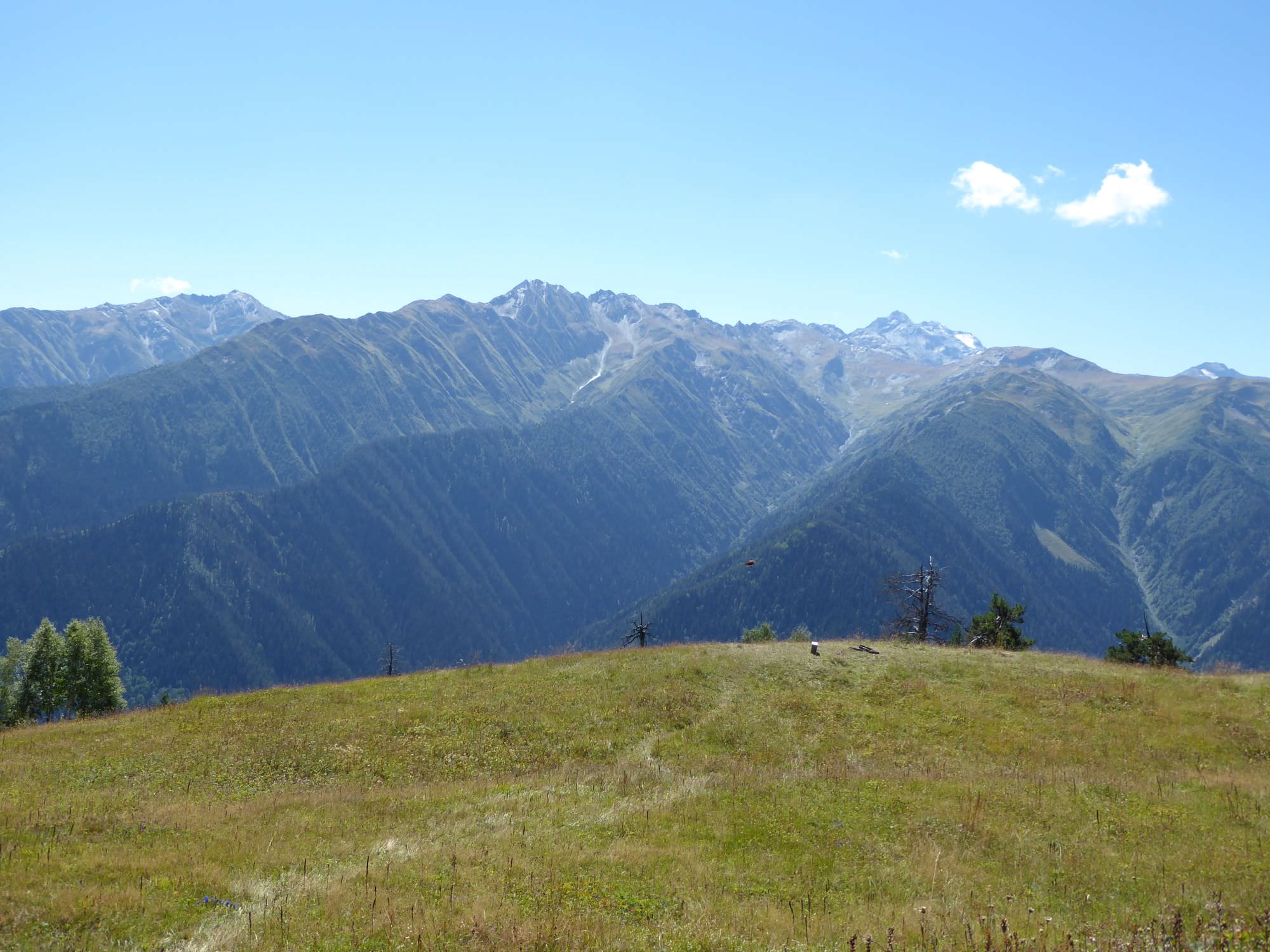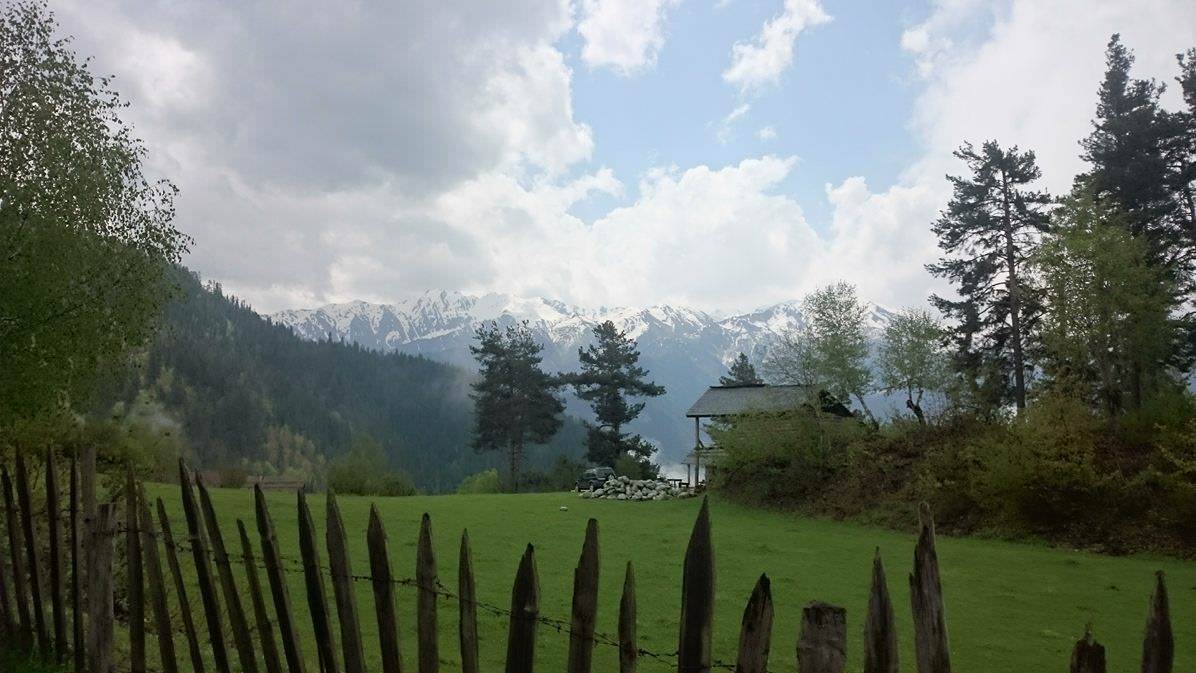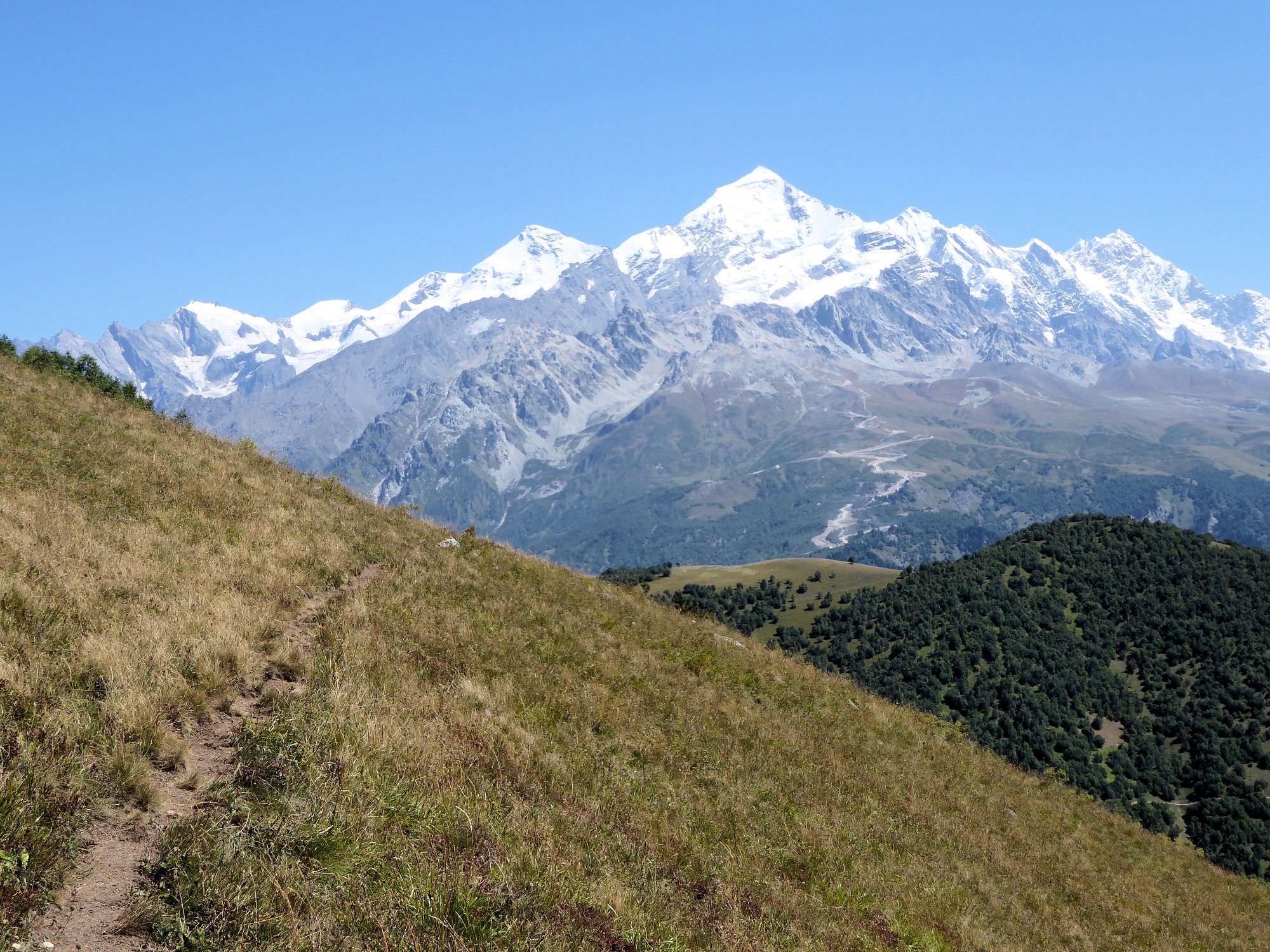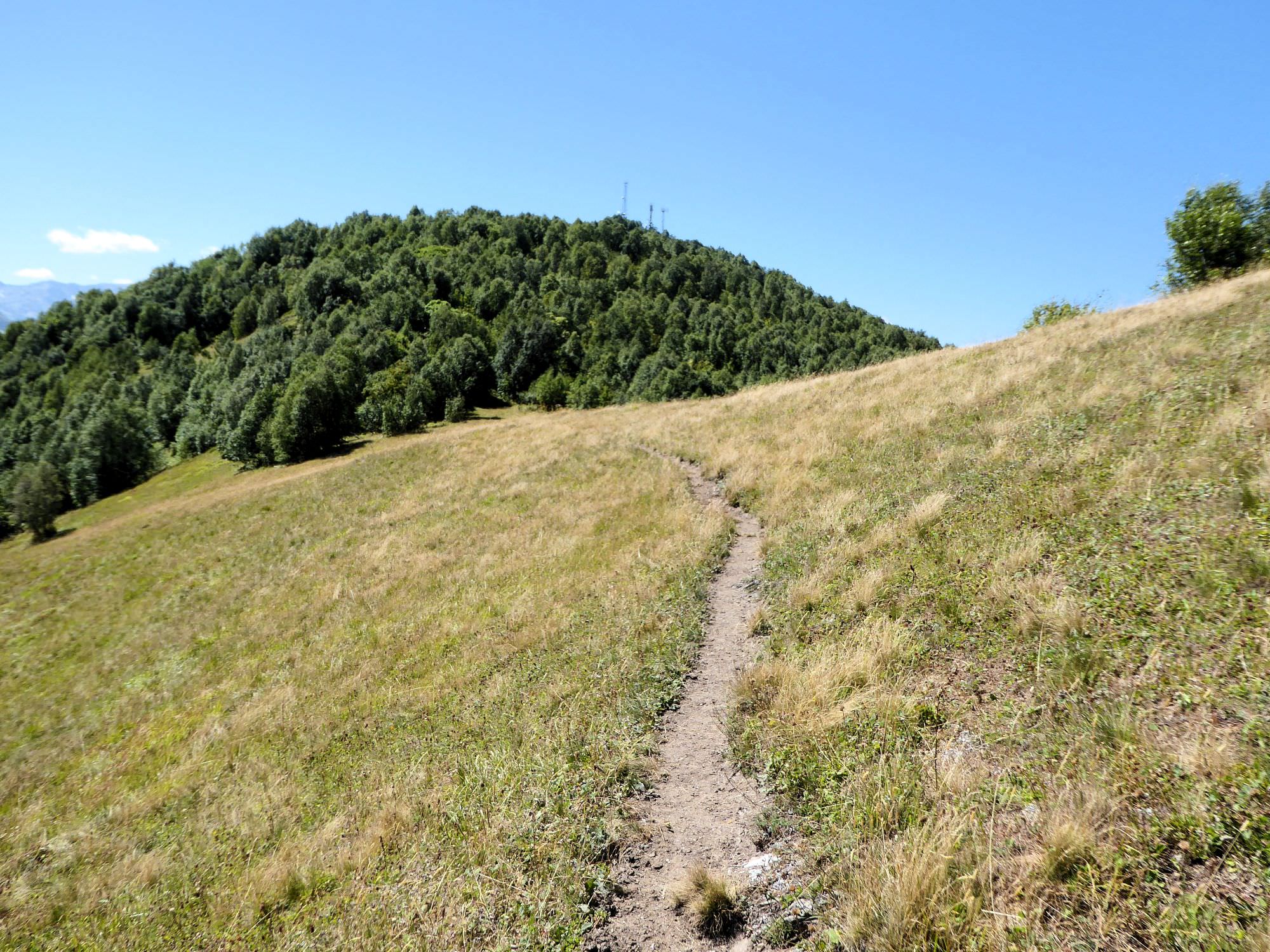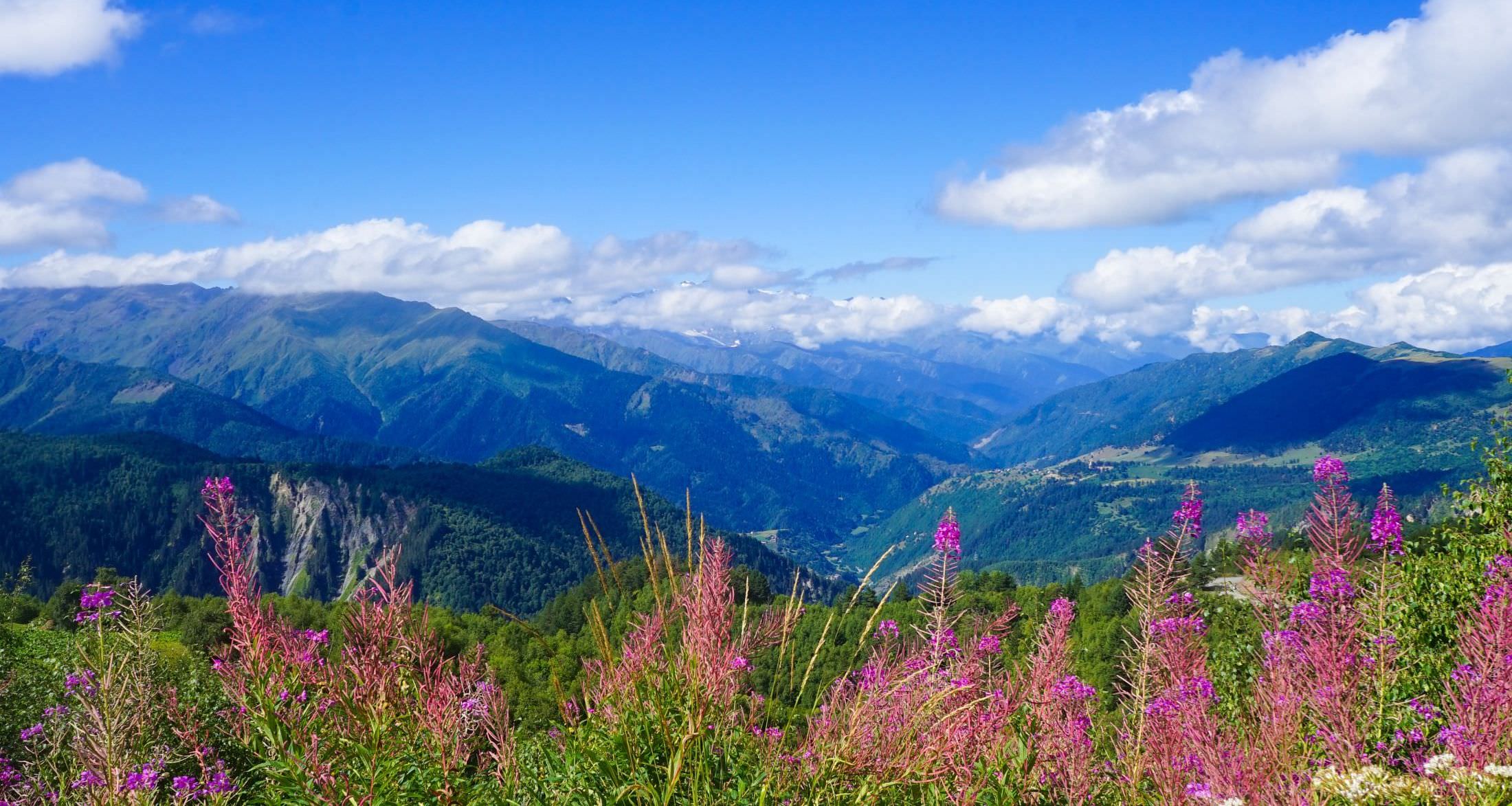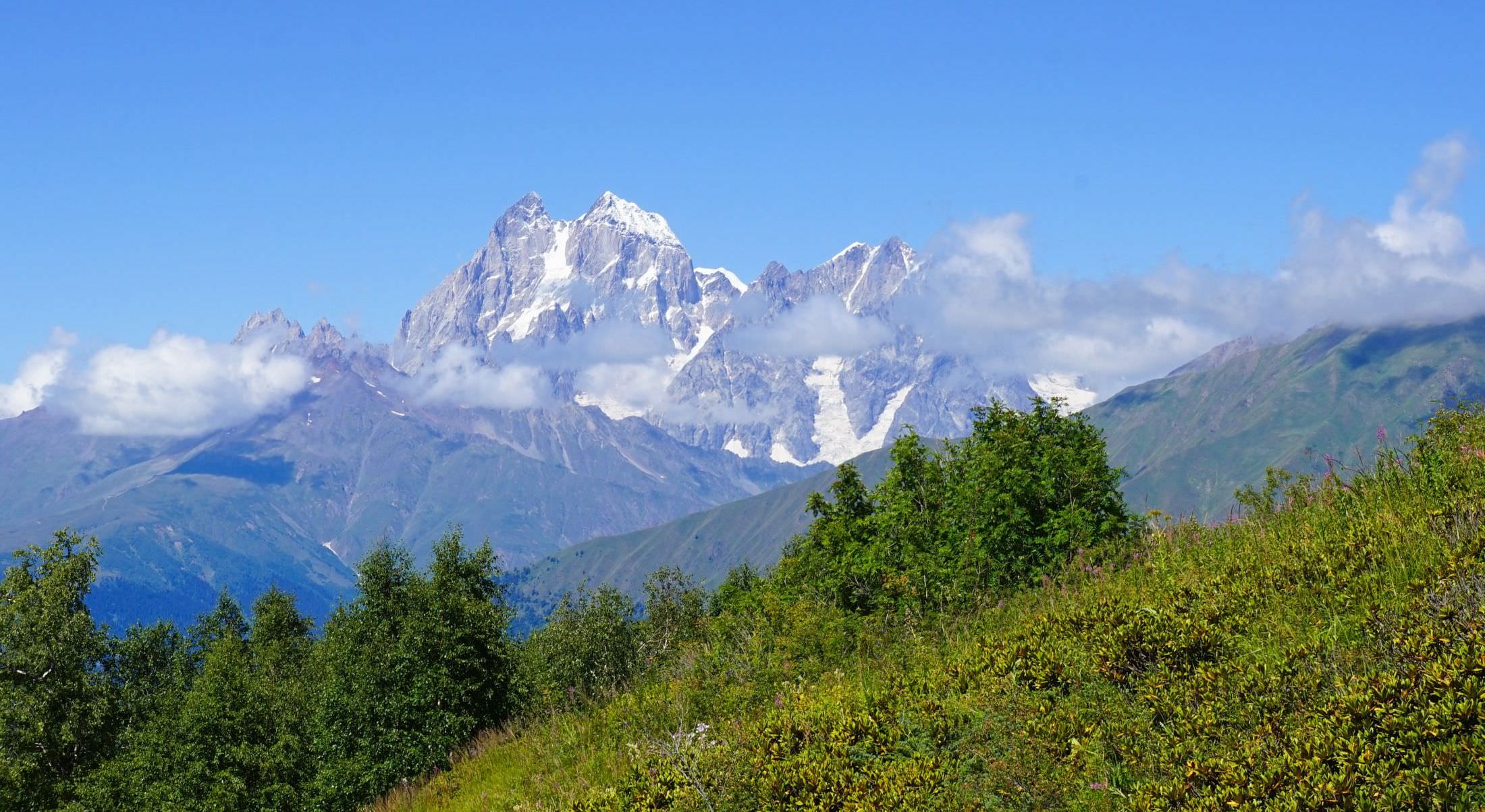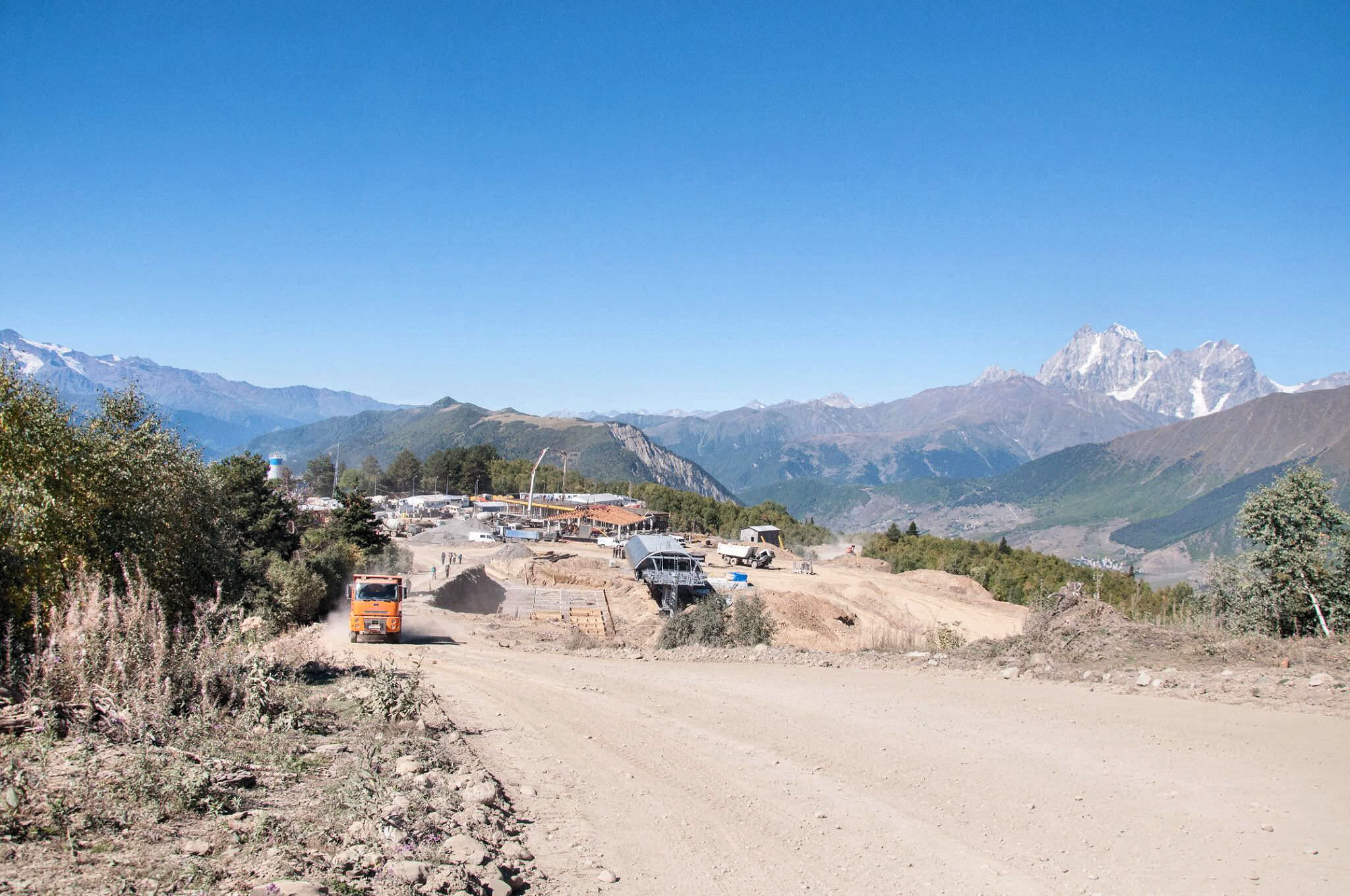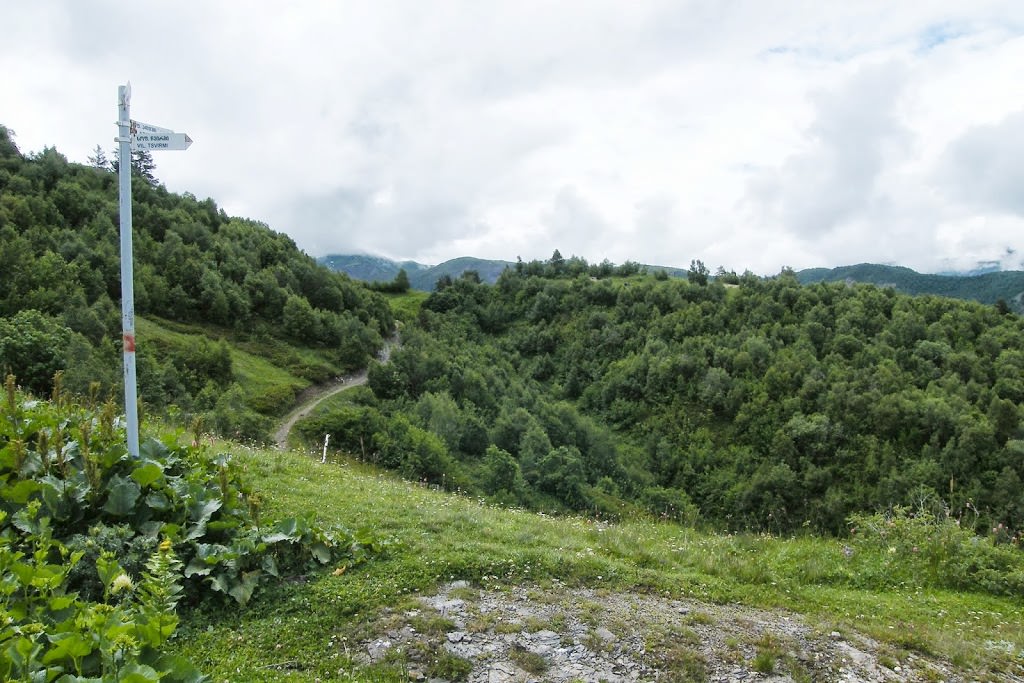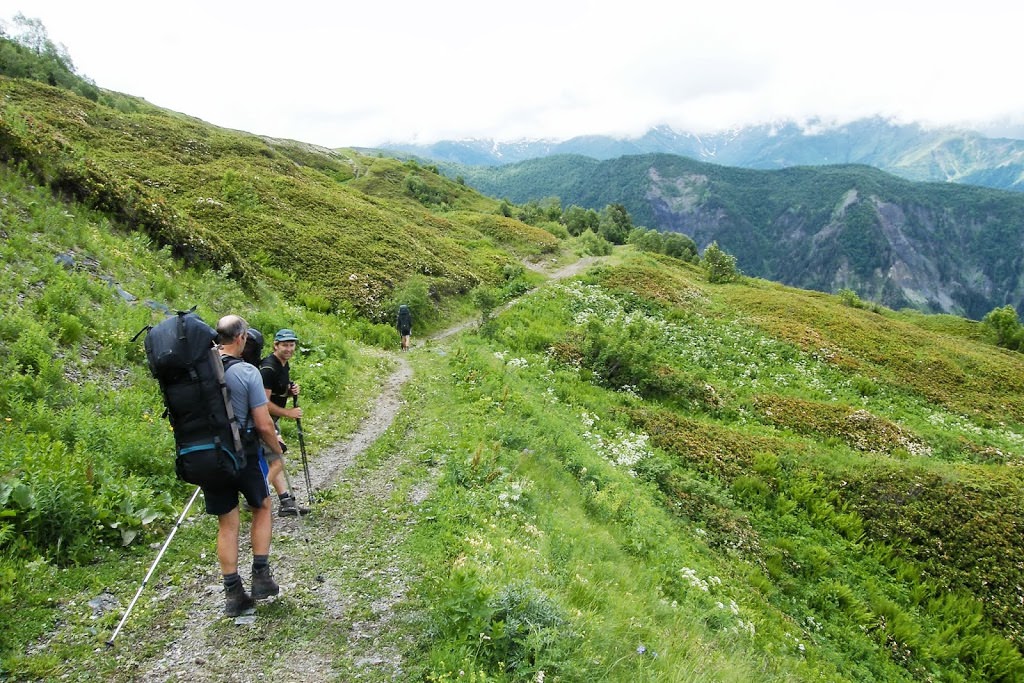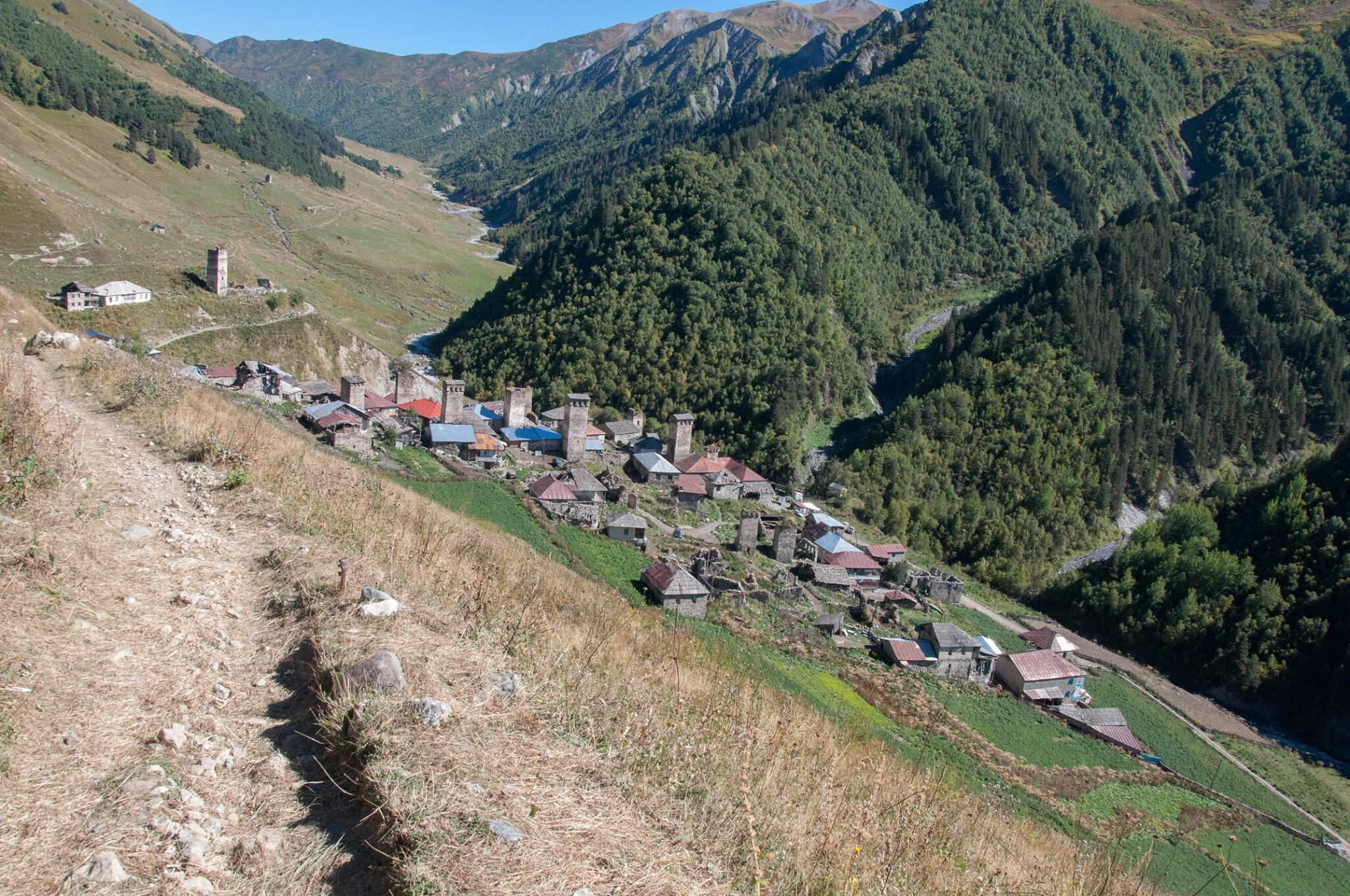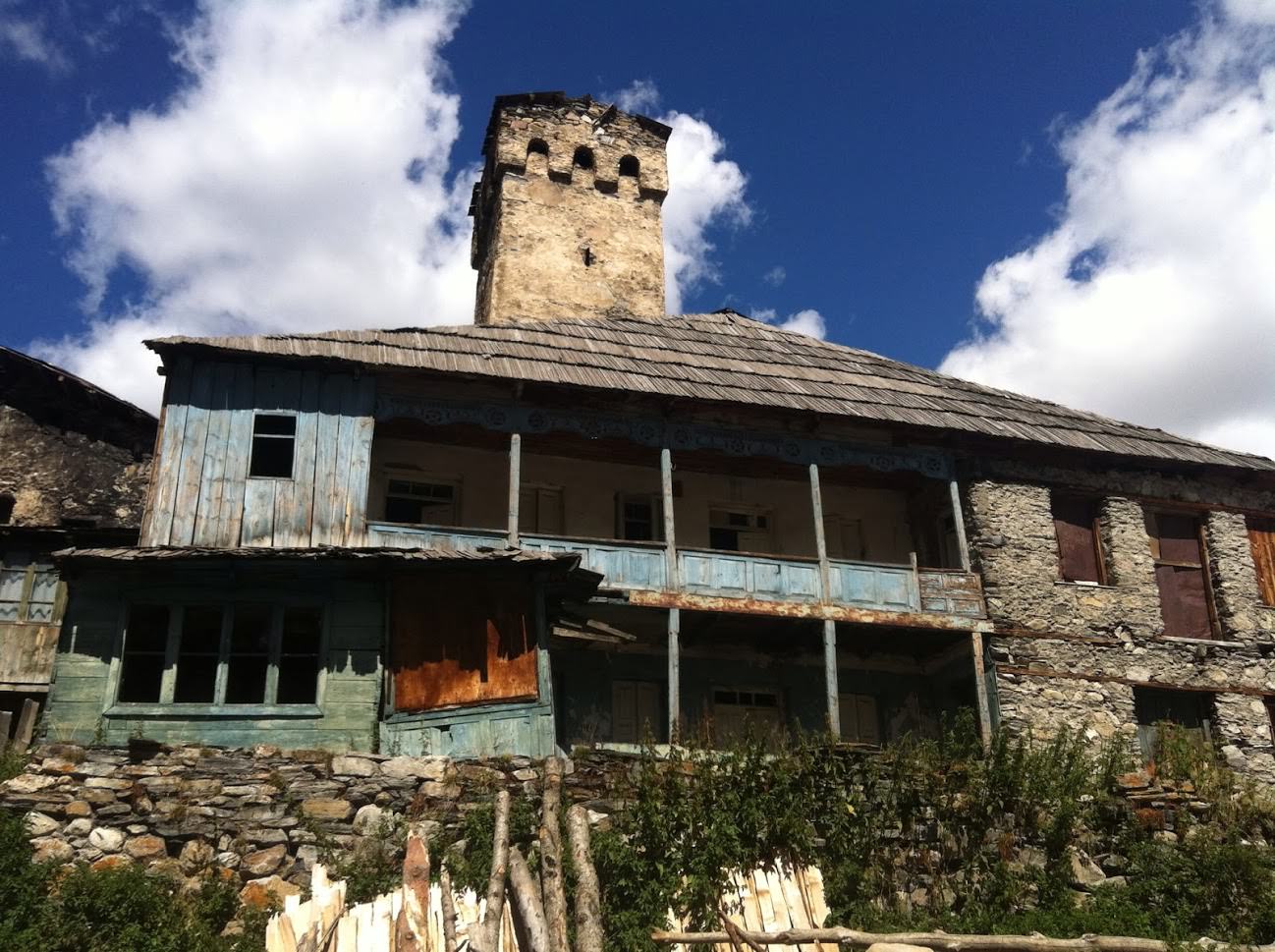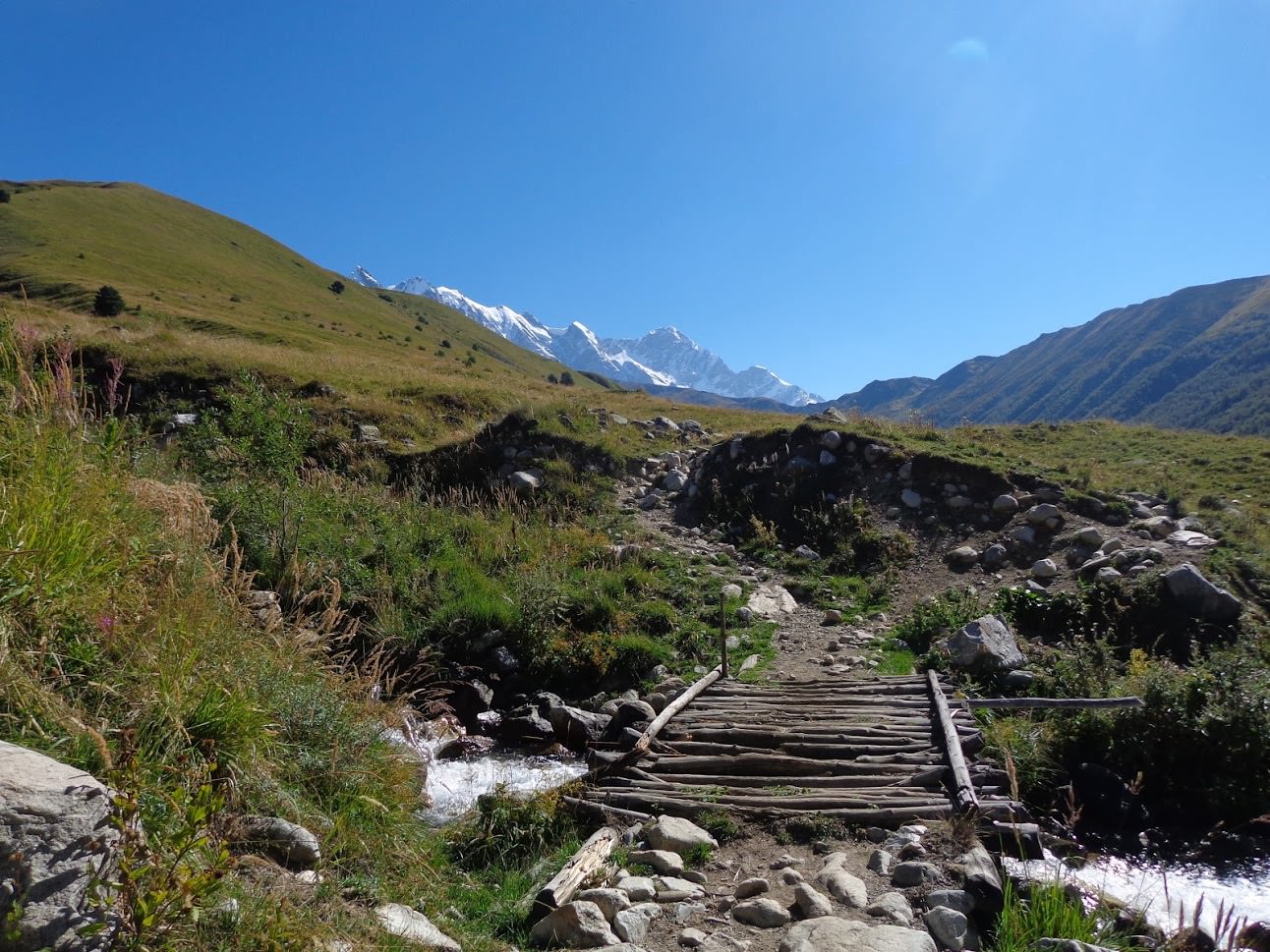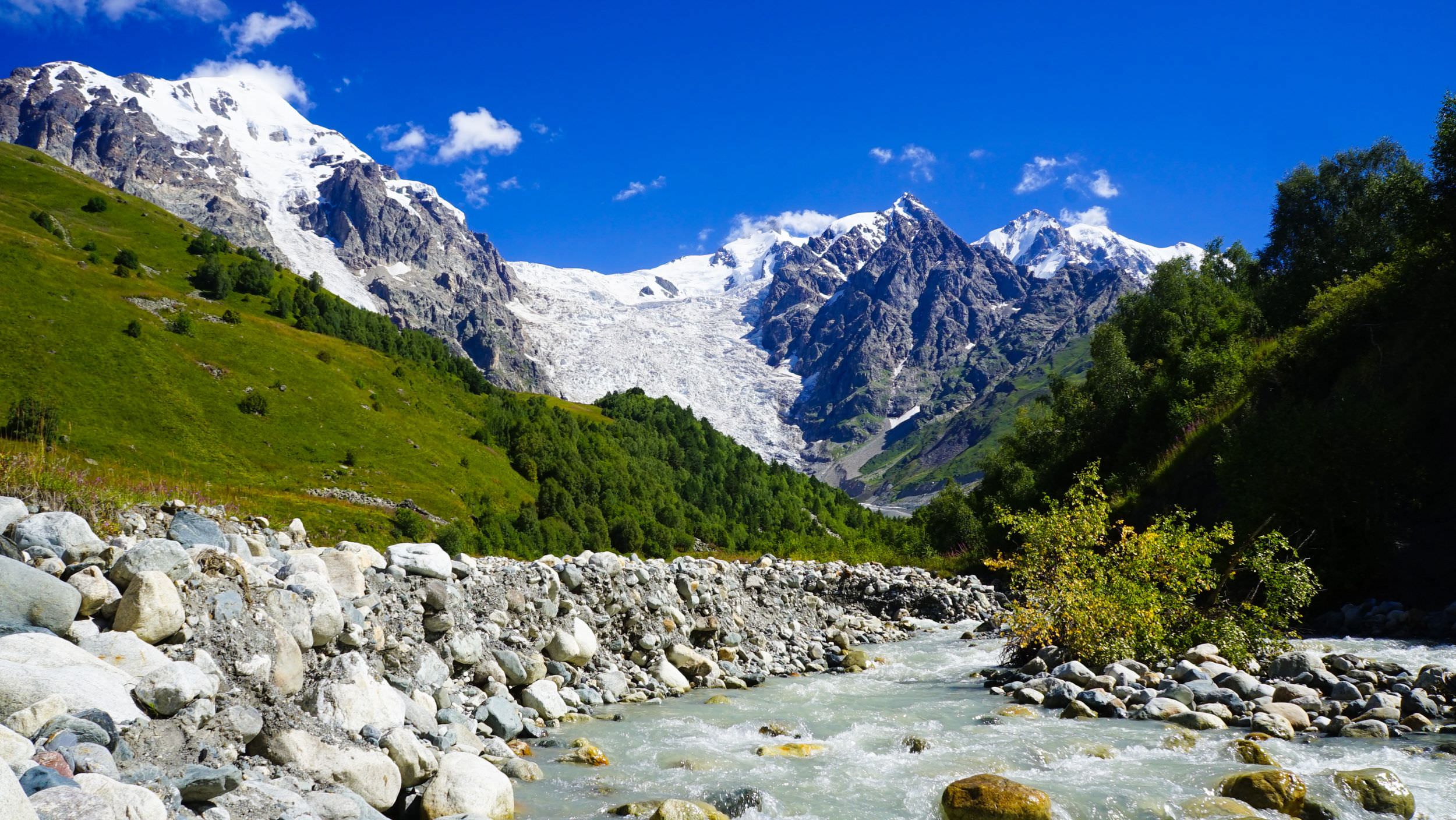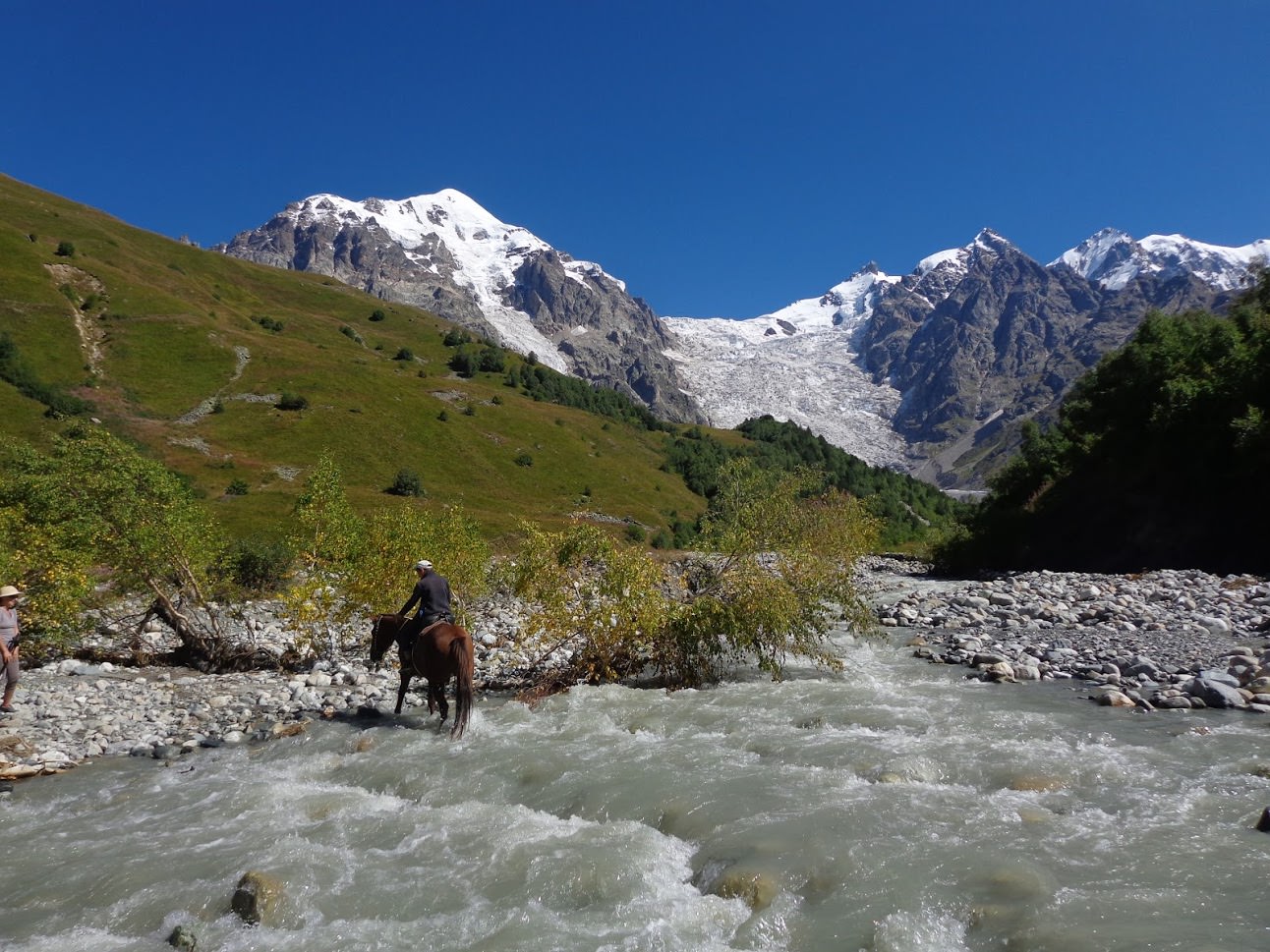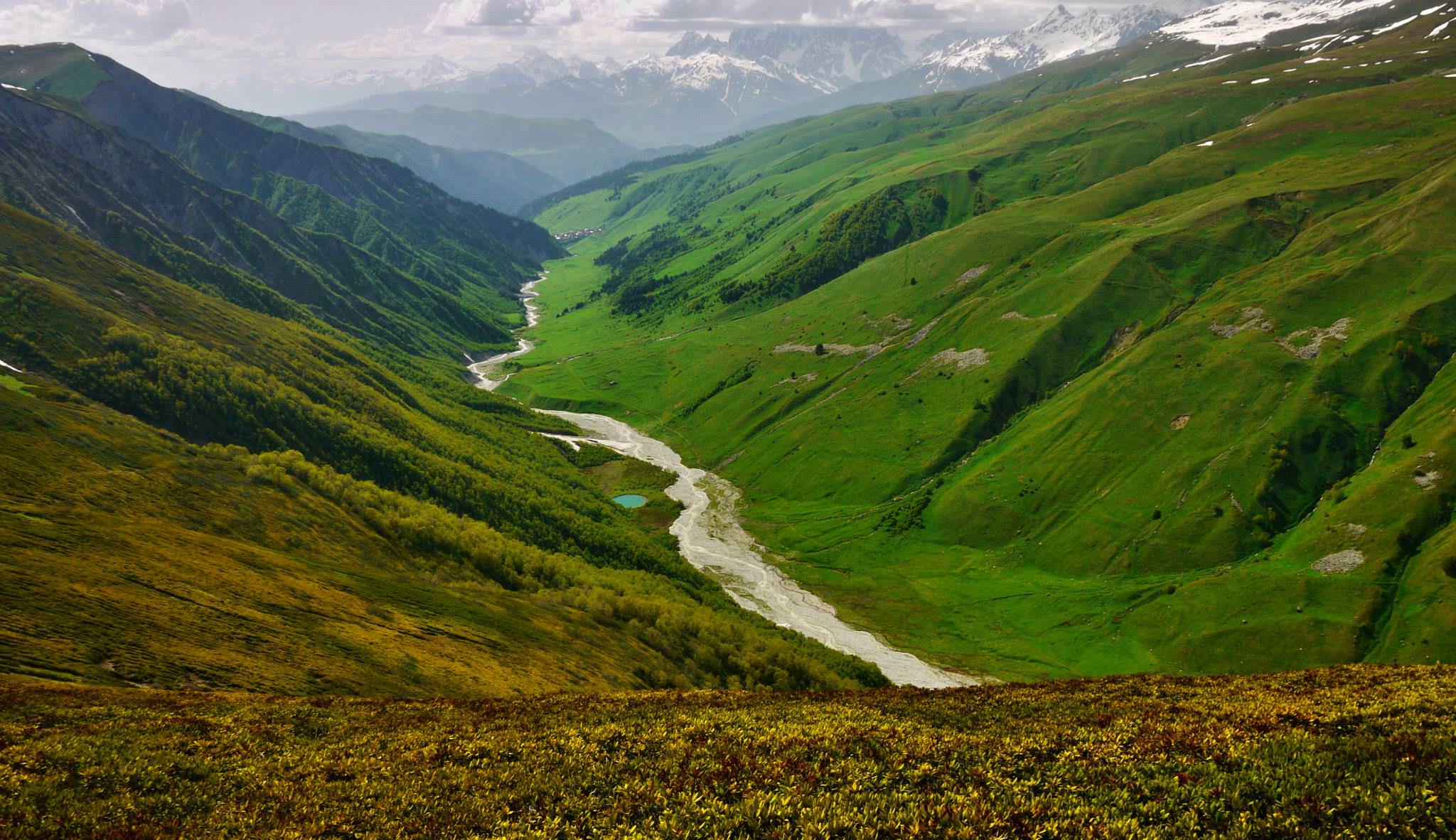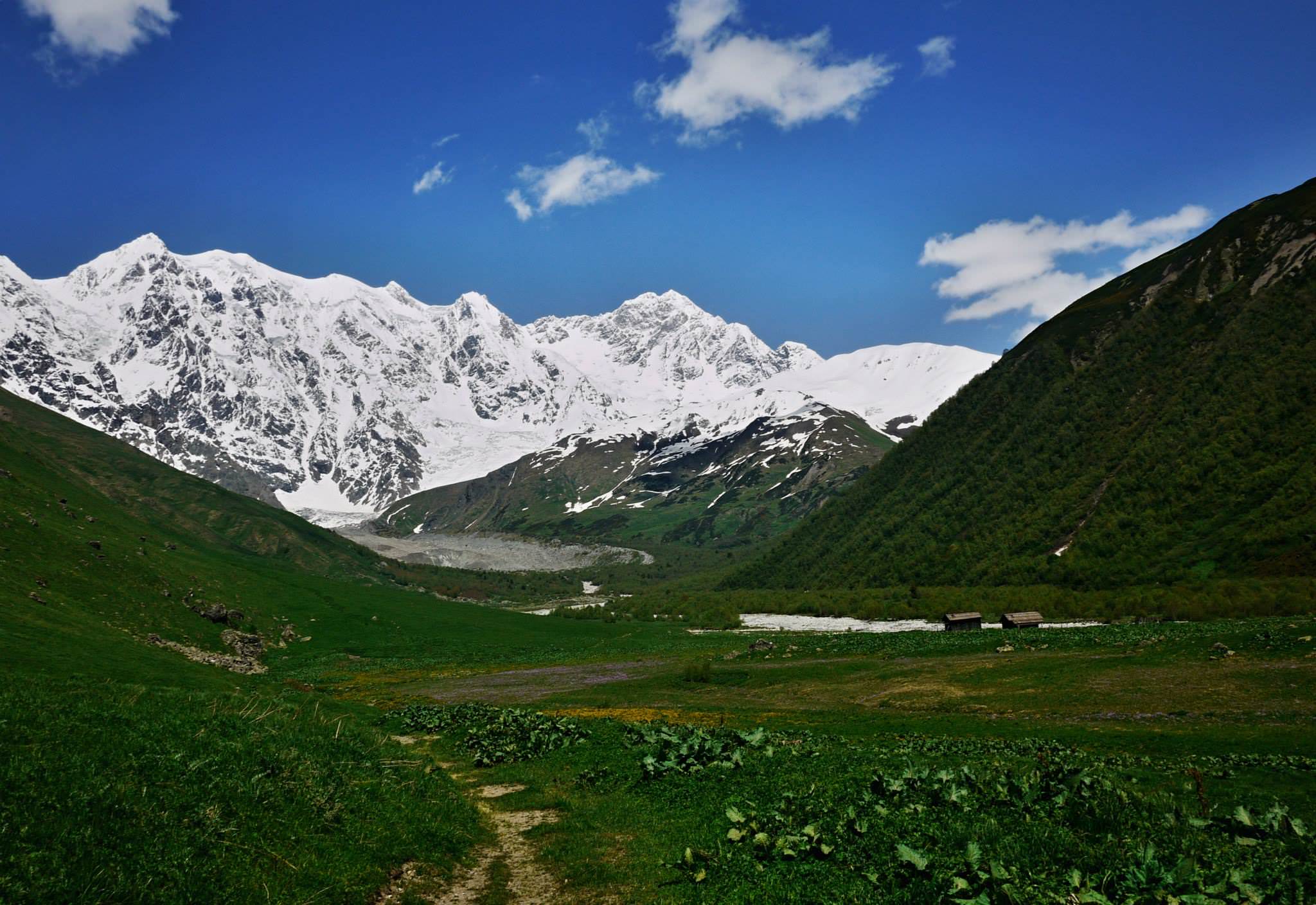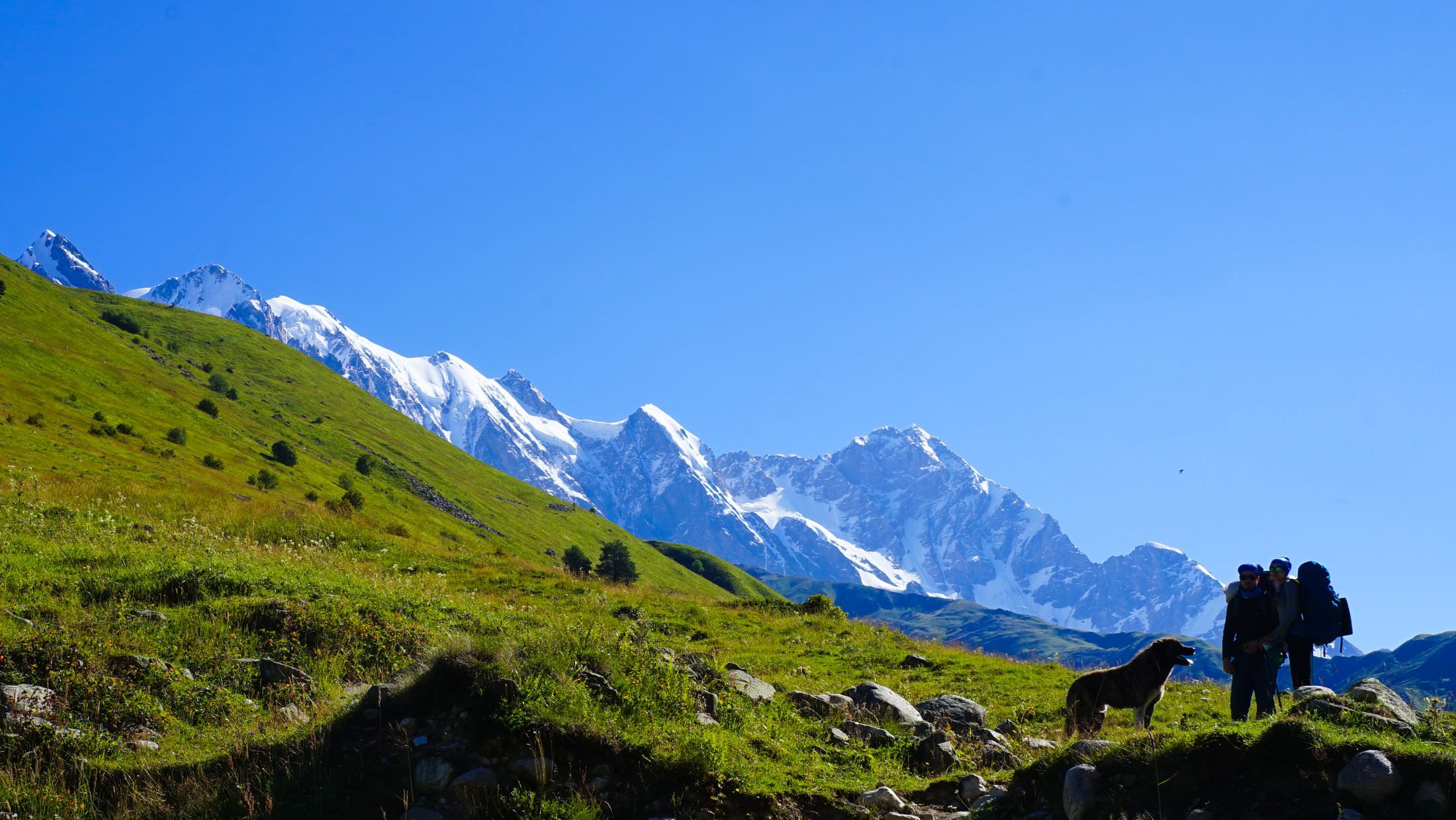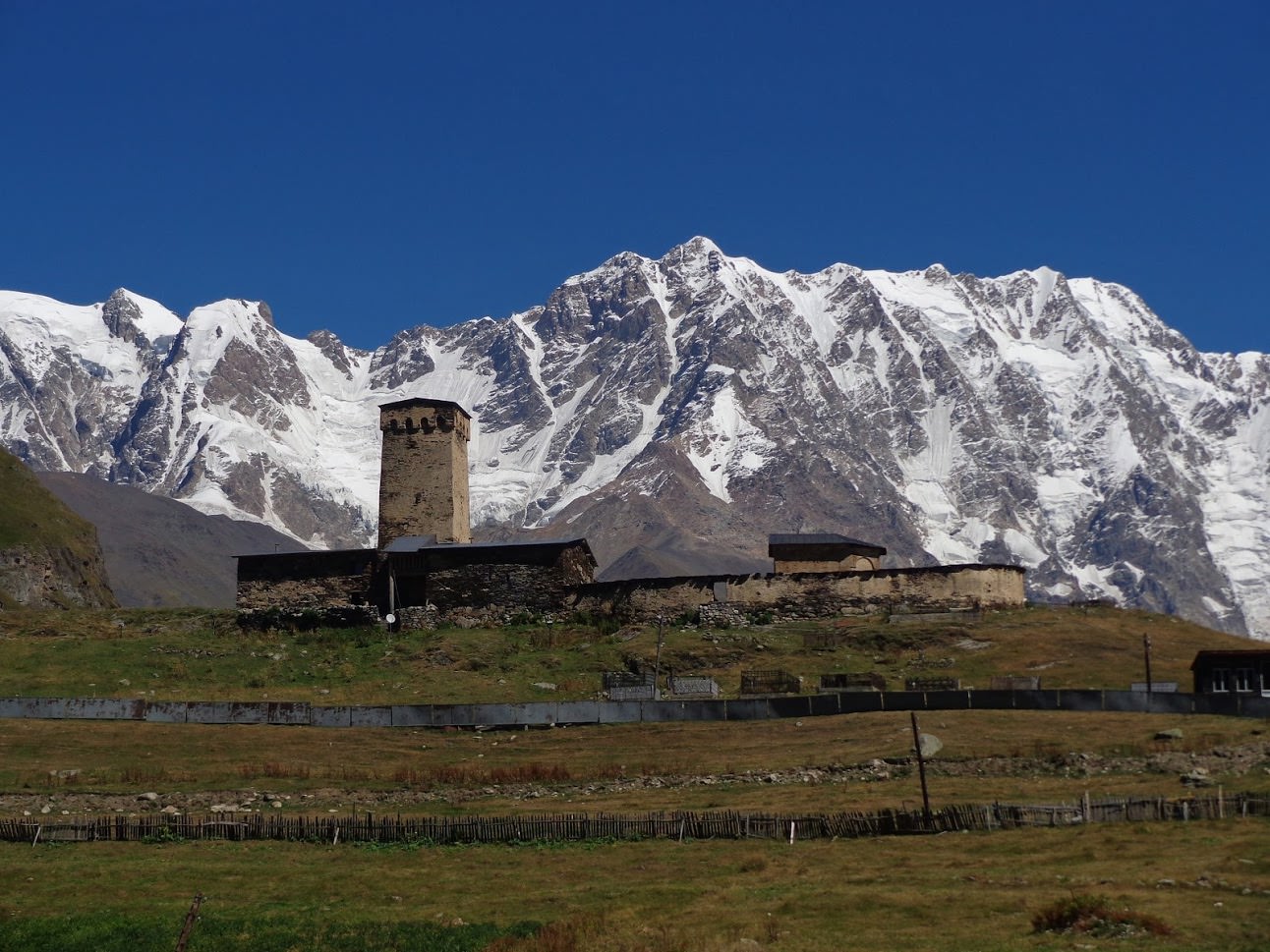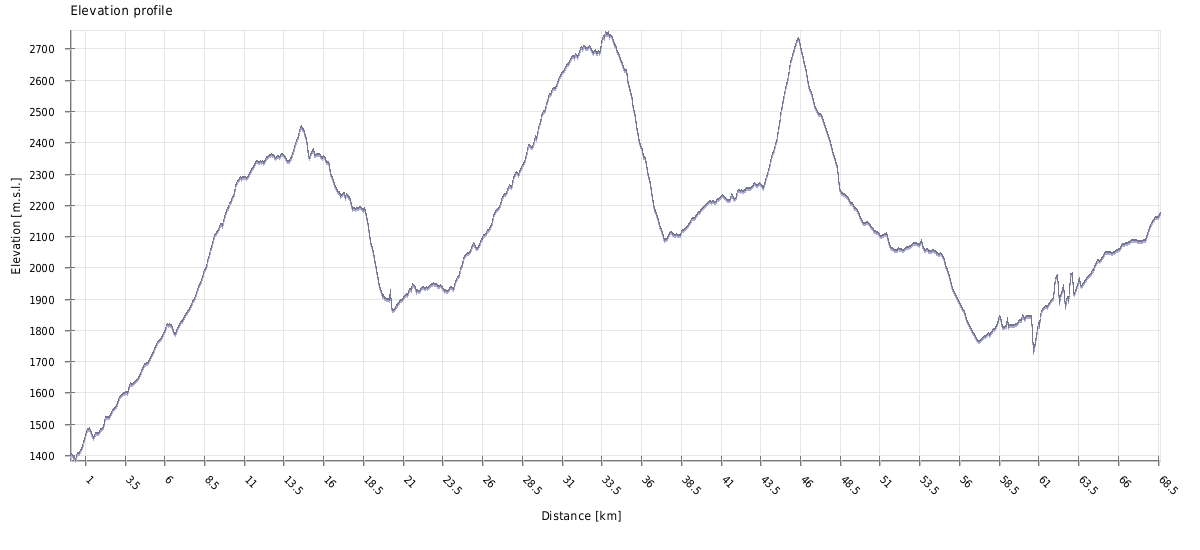

The alternative of the most popular Georgian trek, by mine opinion even better than standard route.
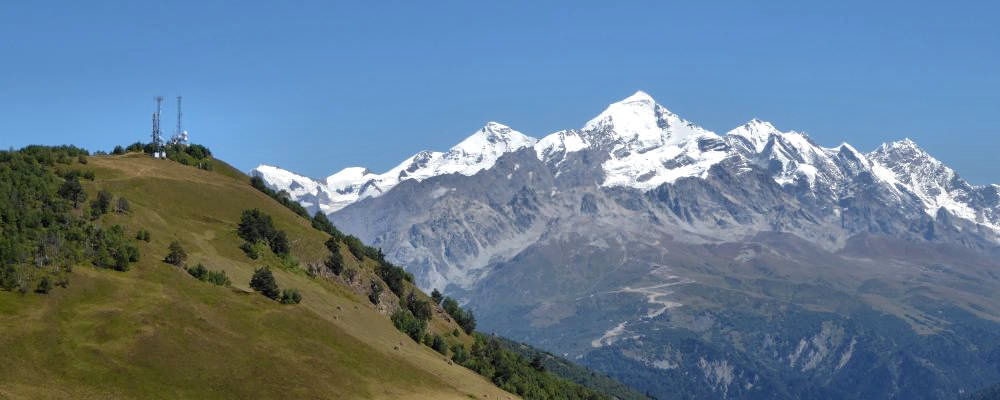
The alternative of the most popular Georgian trek, which is by mine opinion even better than a standard hike via Zhabeshi.
This one climbs onto Zuruldi massif, descends to Tsvirmi village and then follows a new road leading to Tetnuldi ski resort, where it joins the classic trail to Ushguli.
The main advantage of this variant is much better scenery on the first day. A disadvantage is a bit dull start of the day Two.
But overall, this is the marvelous trail and I don't understand why more people don't take it.
The fast walker with a tent could finish this trek in three days, but it's better to split it into four days to be able to sleep in the villages.
The tent is not necessary; it´s possible to spend nights in guesthouses. Also, you also don´t have to worry about food too much - they serve breakfasts and dinners and can also prepare a lunchbox.
People often ask me if it's necessary to book accommodation in advance. The answer is - if you are trekking in July or August and have no camping gear, you should. The locals will probably find you some place to sleep even when they are full, but it may not be the most comfortable option. To book in advance, you can use an online portal such as booking.com - (comfortable, but covers only a few places in smaller villages) or ask your landlord in Mestia to make the booking for you, they have the necessary contacts.
Here, I collected (and answered) questions I get most often.
This one is tricky :) But if you are trekking in July or August and have no camping gear, you should - and I am saying it as a person who loathes booking more than 2-3 days ahead. Good places along the trail tend to fill up fast, especially since many of them got registered on booking portals. And while locals are masters of improvisation and will eventually find you some place to sleep, it may not be the most comfortable option. So, if you want to play it safe, you can book online several long time ahead - at the end of each day section, I included a couple of places which I recommend.
A compromise might be to ask your landlord in Mestia to make the booking for you, they have the necessary contacts and might be able to arrange you a room at some smaller places which have no online presence. And even if this fails, you can always try to leave earlier in the morning and reach your destination before crowds arrive, so you will have more places to choose from.
Looking for a place to stay in Mestia before the trek?
These are my favorite guesthouses
The alternative route to Ushguli has much fewer trekkers compared to a classic route - even in 2019, only a handful depart from Mestia each day. Howver, this changes once you join the classic trail above Adishi. To provide some numbers - during the shoulder season (Jun, Sep), several dozens trekkers tend to depart each day from Mestia (or more or less, depending on the weather). This numbers greatly grow during the summer season - the busiest month is August when the number of trekkers on some days can exceed 150 people (on each day section). That a lot, but people tend to spread during the day so it's not like you are going to walk in a queue.
So, to sum it up, the second half of this trek certainly not the one to choose if you are looking for a silence or solitude. But that shouldn't put you off - the number of hikers is still far, far from crowds you can encounter on some popular European trails.
People usually start from Mestia because Ushguli is a great place to finish the trek - and it's infinitely more fun to journey somewhere where you haven't been yet than drive from Mestia to Ushguli
and then return on foot. Also, it's easier to cross the dangerous stream beyond Adishi which should be done in the morning, when the water level is lower.
However, with the growing popularity of the trek, also the opposite direction starts making more and more sense, especially if you don't like crowded trails. If you hike in the opposite direction than most, you will meet almost all other hikers in a span of one or two hours and for the rest of the day will have the trail for yourself.
Quite popular question since there are many people who don´t come to Georgia for trekking but would like to do the hike. Trek can be certainly finished even in sneakers but it´s not the optimal solution since some parts of trail are slippery and muddy - even more than the "classic trail". Better bring some good walking shoes (even if you don´t plan to hike) but if it´s too late for that, this is one of treks where the lack of proper shoes doesn´t constitute an unpassable obstacle.
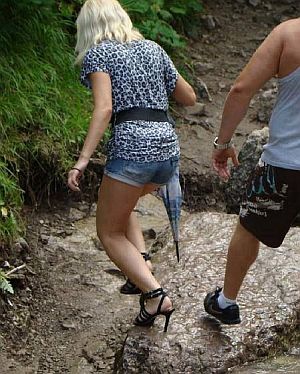
The season for this trek is from the beginning of June till late October. Each period has its pros and cons. In June, one can enjoy green scenery with blooming flowers,
but there is a reason why everything is green and it has something to do with rain. In October, you can admire colorful autumn foliage, but days are already much shorter and colder.
Also, in the second half of the month, one can expect first severe snowfalls.
The best time to visit is during July and August, but that's when most people visit. Therefore, I personally prefer midle of September - weather is still nice and as a bonus, the trail is free of crowds.
I would also like to address one question I get very often - people coming in May often ask me if it is "possible" to finish the trek at this period. I find it very hard to answer. Trekking in sub-optimal conditions means the higher chance of the accident and who am I to decide if this still worth to risk it or not? Especially when I have no idea who is asking. But to give at least some answer, first hikers who manage to finish Mestia - Ushguli trek usually do it between 20th and 30th May. How you use this info is up to you.
From Zugdidi to Mestia:
Marshrutkas to Mestia leave from Zugdidi every day, there is at least one in late morning and one in the afternoon. Morning marshrutka departs from the bus station situated by the bridge around 10 am (or even later if not full). Afternoon marshrutka waits for passengers of morning train from Tbilisi, which arrives around 14:30. Therefore, they wait in front of the Zugdidi train station. There might be some odd marshrutka in-between on you might get lucky and board marshrutka stopping at Zugdidi along its route to Mestia, but that cannot be guaranteed.
Either way, the price of the ride is 40 GEL and the trip takes almost 4 hours, mostly due to a rather large pause these buses tend to make around Khaishi.
If you get lucky or travel in a larger group, it could make more sense to secure your spot at shared taxi that depart from the station by the bridge (and in the afternoon from train station as well). The price tends to be 200 GEL per the whole car (50 GEL pp if the taxi is full), but varies depending on the situation. Trip is faster since any break is optional, takes 3 hours or so.
From Tbilisi to Mestia:
Few years ago, the best option used to be the overnight train to Zugdidi. However, it was cancelled in 2020 due to covid and there are no signs that it's going to be restored anytime soon. The only viable replacement used to be a long-distance night bus, which could also save you a lots of time, but won't be as comfortable as that cancelled sleeper train. Unfortunately, it seems that right now (summer 2023), they are not running them either, only bus leaving around noon, but it might be worth checking out Omnibus website to see if they were reinstated.
Currently, I would recommend the day train. It departs from Tbilisi at 8:20 and makes it to Zugdidi at 14:31, just in time to catch some of the last marshrutkas to Svaneti. The price of the ride starts at 16 GEL, which is less than 5 EUR. Tickets can be bought in advance at matarebeli.ge website (the official web is railway.ge, but that never worked for me). Just one important thing - tickets are released for the online sale only some 15 days in advance, but it's not explained anywhere. So don´t freak out if you can´t buy your ticket online because of the "no tickets available", "trains not found" or some similar error. Just try later :)
If you fail to secure the spot on the train, you may be forced to take a direct marshrutka - two minibuses depart at 7:00 from the area in front of Main Railway Station, come at least 30 minutes earlier to catch a spot. Another one departs at 8:00 from Samgori railway station and there should be something from Didube as well. The price is 40 GEL, so it´s quite cheap, but I can´t recommend it since this uncomfortable journey takes grueling 9-10 hours - basically, it's just slower, marginally cheaper and much less comfortable alternative for the day train.
If the are not travelling alone and don't mind spending some extra bucks, you might prefer a direct taxi. Those can be either arranged at bus stations or prebooked - looking at the prices of one of the most popular Georgian transport website, gotrip.ge, prices for the private transfer from Tbilisi to Mestia start at 650 GEL (230 EUR) for the group of 4.
The last option you could consider is flight - there are 4 flights a week from Natakhtari airport near Tbilisi, operated by VanillaSky company . You would see Caucasus from a completely different perspective and for 90 GEL it´s quite a bargain. On the downside, they occassionally get canceled because of the weather and during the summer, you should book at least month in advance since they get booked up pretty fast. For more info, pls check this excellent post about the flight (covers also flight from Kutaisi).
From Kutaisi to Mestia:
This depends on whether you want to get to Mestia from the city or from the Kutaisi airport.
In the first case, your best options is the direct minibus (the price is 40 GEL) departing from the station behind McDonalds. There is a fixed departure between 9:00 and 10:00 am, but if you want to secure your spot, better get there at 8:00-8:30 since it's popular among tourists and will depart much sooner if full.
According to locals, if this marshrutka gets full and leaves before 9:00 am, they will send another one. If it gets full later, they might not.
There may be also others during the day if there are enough tourists, but I wouldn´t rely on that. If you miss them and there is none other direct bus available, look for a marshrutka to Zugdidi (price 10 GEL) - it's the same way and you can find there transport to Mestia more easily (especially if you notify your driver in Kutaisi that you need to continue to Mestia).
If you are travelling directly from the airport, you also have some options. If you are travelling alone, you can arrange a transfer to Kutaisi at Georgian bus stand (5 GEL or so) and take marshrutka from there. Or, if you are willing to spend extra money and save time, find someone to share taxi with. It's actually pretty easy - do you see any people with hiking backpacks? If yes, there is a pretty high chance they are heading to Svaneti so this is a great chance to save some money and get to know some people.
If you are not alone and travel straight from the airport, you might want to book your taxi in advance. In this case, at gotrip.ge, prices of the transfer from the Kutaisi airport to Mestia start at 340 GEL, which is actually pretty solid. If you haggle with taxi drivers loitering around the airport and don't look to desperate, you might get a better price, but not by much.
From Batumi to Mestia:
Marshrutka is the only option, it departs from the main bus station. Since you will have switch the bus in Zugdidi (you may have to wait for several hours there), this ride takes a better part of the day. The first bus departs at 8:00 am, then there should be another one at 9:30 am.
If you need to return to Mestia, your best bet used to be minivans making day trips from Mestia to Ushguli. They usually had a few empty seats on the return trip which occured around 3 pm. . However, in the past years, drivers became reluctant to bring hikers back since the Ushguli drivers try to claim all hikers that reached village on foot and other drivers don't want to have problems with locals. So don't rely on these buses too much. So what to do? You can either take a taxi from locals (costs as much as 40 GEL per person) or walk on the road towards Iprali and once the village is out out sight, try to stop some minivan with daytrippers, that should be a bit cheaper.
It's like cab mafia there, we managed to get in a bus for 20 GEL but the cab guys saw it, followed by car, stopped the bus and made us leave it. We kept walking since we didn't want to support this behavior and they even followed us half an hour by car. Later on the gave up and we manged to get another bus.
If you want to prolong your trek, you can cross into Lower Svaneti on foot via Latpari pass or Zagar pass.
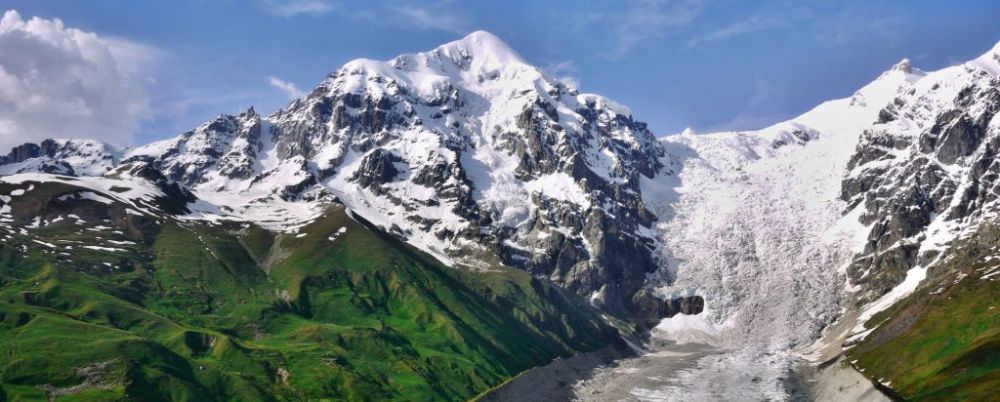
| Distance | 68,7 km |
| Trail type: | AB trip |
| Max. elevation: | 2759m |
| Min. elevation: | 1385m |
| Total climb: | 4535m |
| Total descent: | 3761m |
Before I start, I need to stress one thing. The description here explains the walking route. However, there is a new cablecar which will take you from the edge of Mestia right to the top of Zuruldi ridge - this way, you will skip the harder and less scenic half of the hike - ideal if you reach Mestia before noon and want to start trekking right away. I am sure that most of the hikers will take a cable car (it costs 20 GEL) and there is nothing wrong about it, this "purists" route is here only for the sake of completeness (and for the times when the cablecar is under maintenance, which happens surprisingly often during the high season). OK, and now let's get back to the purely walking route.
The trail starts at Seti Square. Leave it by a street heading to the southeast, after 200 meters cross the bridge and turn right. Cross another bridge and walk by a museum. Main road here bends to the east - follow it, pass few more houses and leave the village.
After some 300 meter, turn right onto the road leading to the new cable car. Pass the new station and enter the forest - then follow the footpath until you reach a concrete road. Turn right and follow it for half an hour, until you come to the intersection where it sharply bends to the east (towards middle Hatsvali station) and dirt road continues in the original direction (as the pointer says, towards Heshkili). Walk so far is quite boring so it´s not a bad idea to hire a taxi to take you here (should cost about 20 GEL or so).
Leave the concrete road and follow the ntinue on the dirt road in the direction of Ieli village, there is also a pointer. Soon you will come to the almost abandoned Heshkili village, which recently became popular due to Heshkili huts.
Here comes the tricky part. Near the first house in the village (the one on the photo) you need to turn left, onto the dirt track climbing uphill.
Just to make it clear - if you don't turn left at Heshkili and stay on the main road, it will descend to Inguri valley and lead you to Tsvirmi village even more comfortably. However, this route is not so scenic, so I prefer the higher trail. Still, this lower route is also the valid options, especially if the weather is not so good.
But enough about the easier route. Follow the ascending track from Heshkili all the way to the upper station of the cable car - it's quite a steep climb as you will have to overcome 400 meters of elevation. This is the place you can easily reach from Mestia if you use the cable car.
From the cable car, head to the east. Walk between trees, cross the small meadow and you will come to a bigger dirt road. This road will take you all the way to Mentashi transmitter, which is already visible to the east. There is only one crossroad halfway to the transmitter in front of a small hill - if you take left branch, you will climb to the nameless transmitter (limited views), if you take the right one, the trail will bypass the mount. No matter which path you choose, both will merge again and you will have to climb 100 height meters to another transmitter. Mentashi hill offers breathtaking views in all directions and is a great place for a break.
Then we continue eastwards. Descent from Mentashi is a bit tricky as the terrain is very steep and the path not always visible (to put it mildly). Some people prefer to circumvent whole Mentashi hill from the right side, especially in bad weather.
You need to make it to the meadow in the northeastern direction. Once there, find a small path heading northeast. Follow it. You will cross several other pastures and belts of trees and after amazing two kilometers, you will come to a spot where the trail turns north and dives into the forest. From here its supposed to continue to Mulakhi village. Tke first section is OK, but further stages are in a poor condition so I don't recommend it. But if you have time, you can make a small side trip - after first 300 meters, there is a meadow with nice views of Mt. Ushba.
In case you want to go directly to Tsvirmi keep walking east. Follow the grassy path between trees - on your left will be a dense forest, on the slope below you a small group of trees. Once you walk pass this grove, turn right and descend some 50 meters. You will find a path, which soon turns into regular dirt road - too narrow for a car, but wide enough for a cart. This road will take you all the way to Tsvirmi.
Tsvirmi is a lovely small village, barely touched by tourism. Still, you can find there an accommodation - you will stumble upon a guesthouse soon after you enter the village.
In the past, Tsvirmi was visited only by few tourists and so it managed to retain a lots of its charm. However, that also meant that the offer of accommodation was very limited. The situation changed only in the past few years and nowadays, the village boasts at least 4 guesthouses. Only one of them can be booked online but even if it´s full, there are enough alternatives.
Shorena's guesthouse - added to Booking.com only in june 2019, but looking at the photos, I am almost sure this is the place where I stayed few years ago. This very pleasant homestay lies at the northern edge of the village, right by the trail descending from the Zuruldi massif. The family running it was really lovely and the food was good and plentiful. During my visit, their beds were somewhat saggy but I heard that this was also fixed in the meantine so now can be this guesthouse strongly recommended.
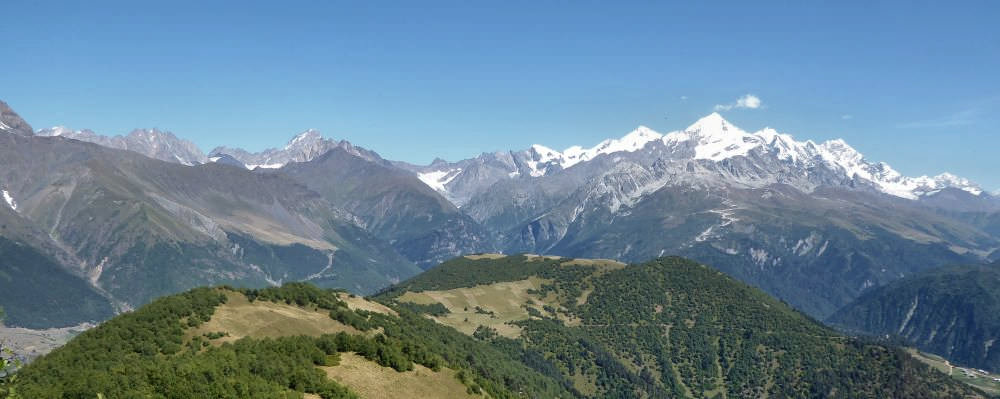
In the morning head to the center of the village, where you will find tourist marker. From here we set off in the direction of Zhabeshi. Just follow the road heading north and after two kilometers it will join the main road from Mestia to Ushguli at Ughviri pass.
Turn right and almost immediately, after fifty meters turn left onto the new road heading to Tetnuldi Ski Resort. You will need to follow it, until you reach the cable car station. If you want to tkae the upper trail to Adishi, buy a ticket, othewise, keep walking. Follow the road and skiing track uphill. Some 20 minutes later, roughly at 2500m altitude, a marked trail (Hadiish) branches off to the south-east. The path crosses open areas with nice views and wildflowers and then slowly descends into the forest. At some point, before crossing a stream, there is a small bar where you can buy some refreshments. Less then an hour later, you reach Adishi. The village is hidden below the slope and you will see it at the last possible moment.
Upper trail to Adishi: If you want to enjoy even better views and escape crowds for a while, this trail might a good alternative. Compared to the classic trail, it starts further uphill, some 200 elevation meters higher, conveniently close to the exit station of the lowest cable car line, the only one which works in summer. Because of this, I strongly recommend to use the cable car to overcome to most difficult section of this day. The price of the ticket should be some 10 GEL.
This upper trail traverses the base of Tetnuldi mountain through the open grasslands. Finally, it turns souths and then comes a steep descent to Adishi. Overall, I think it is a pretty good way to prolong this, otherwise quite easy, hiking day. The only disadvantages are that the final descent could be pretty hard on your knees and there are no bar on this route.
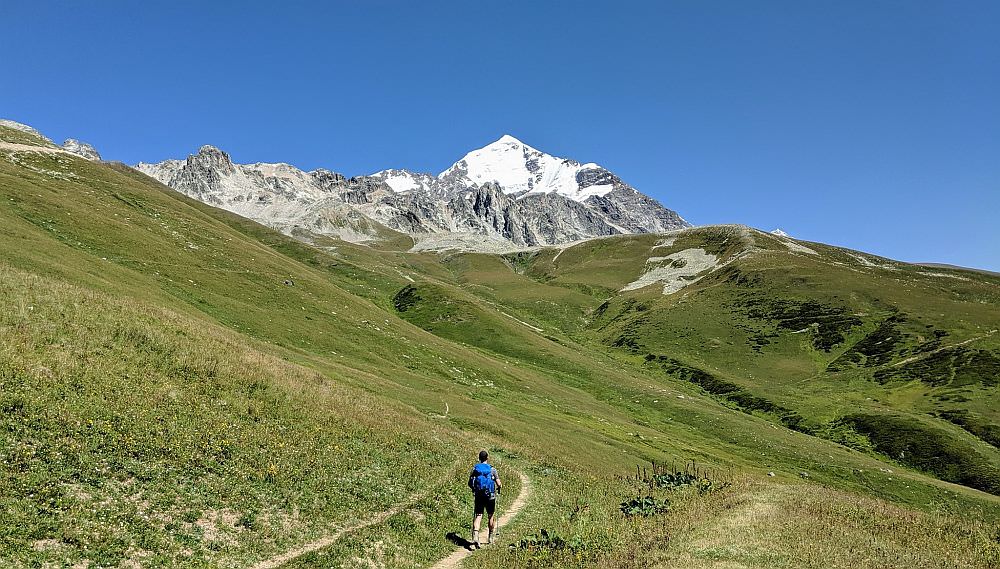
Upper trail to Adishi, Georgia
Adishi, the most isolated village on the trek is the notorious pain point. The village is quite small, there is only a handful of guesthouses and these mostly had no online presence so booking far in advance always posed a problem. Moreover, several of these guesthouses are at best average - the facilities are very basic, food only decent, prices quite high and the owners are often moody, sometimes very friendly and sometimes not so much (the only bright exception being Panorama guesthouse). However, considering the amount of hikers which come here only to spend a night and leave after breakfast, it's not that surprising. Here are some of the better guesthouses where stayed either me or my friends. There are also others, but I have no feedback about them - feel free to write me how you like them :)
Panorama guesthouse - Hands down the best (and most expensive) guesthouse in the village. Opened only in 2019, owners Tamara and Davit decided to bring services provided in Adishi up to the next level. Guesthouse is known for delicious food, comfortable beds and modern bathrooms with hot water. And, of course, both owners speak fluent English and do their best so their guests feel like at home.
However, there is a downside. Since these owners are not locals, guesthouse is not open all year round, only during the season. And sometimes they open quite late, for example, in 2023 they opened only on 4th August.
Elisabeth Kaldani's guesthouse - large, blue-painted wooden guesthouse situated at the bottom part of the village. Until recently, this was the only guesthouse in Adishi available on Booking.com so was always packed with hikers. Several of my friends stayed here and while they weren't particularly impressed, it was "good enough". Elisabeth speaks basic English and works hard to keep the place running and clean. Earlier, I heard some complaints about the food being only average but since the covid hit, the quality of cooking has greatly improved.
Tarzan & Nino - Pleasant guesthouse ran by a friendly older couple - this is where I stayed during my Adishi visit. While the beds weren't too comfortable, the food was good - if you don't expect luxury, you should like this place. Contact: (+995) 790 870794.
Gunter Avaliani guesthouse - Classic Adishi guesthouse, ran by Gunter, his wife Zaira and their daughters Nana and Jameki. The house is old and facilities very basic, but the family is really friendly, they even sang and played music for and with their guests when my friends stayed there (but that depends on the mood, don't expect it each evening). Also, the meals are excellent. Contact: (+995) 598 477180 (Nana speaks also English )
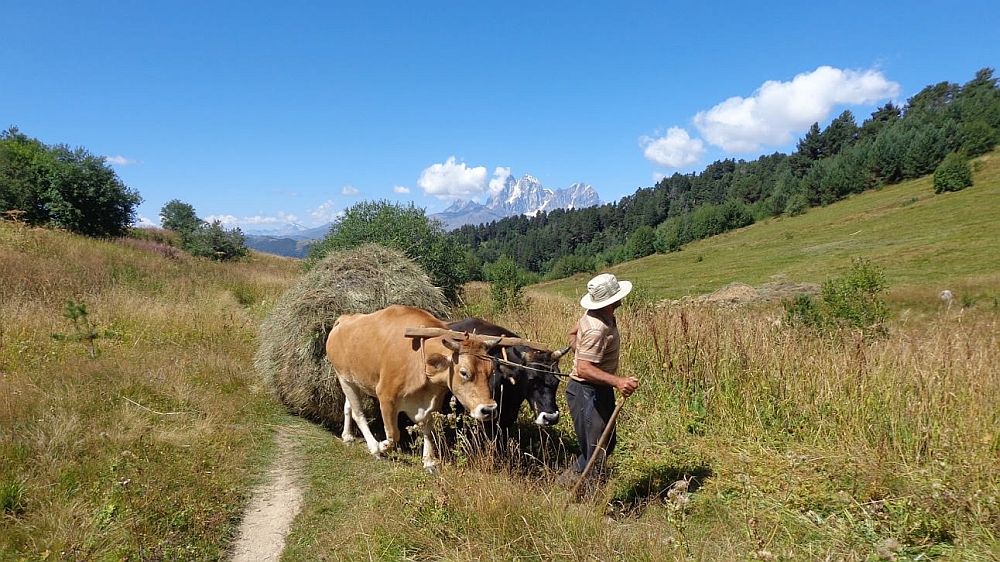
Another day and another tricky part in the morning - fording of the Adishi river. During the main season, when many hikers leave Adishi to Iprali, you can expect people with horses waiting at the crossing. During the shoulder season, it is good to ask around in the village about the water level and hire a horse if necessary - several locals offer this service.
Leave the village by a path heading by the river to the east, to the foot of Adishi glacier. After one hour the path ends in a river - you will have to ford it. During the season, there are usually several locals from Adishi with horses which offer transport, However, they charge 25 GEL or even more per person which is, considering the duration of the ride, usually quite a ripoff (unless the water level is high, then it´s worth every penny). Before you pay, I recommend to walk some 50 meters upstream where the river branches a bit more and check if you can cross on your own - that doesn´t mean it´s always possible, but it´s worth checking out. The water is freezing so you won't be able to spend too much time in the river. Wear hiking sandals and use hiking sticks. But don't take any unnecessary risk and use a horse if you don't feel confident.
Behind the river, the path appears again. After 2 hours of climbing, you should make it to the Chkhunderi pass (2655m) -
it offers great views of surrounding mountains and the Adishi glacier.
If the weather is nice, you can leave your backpack at the pass and walk along the ridge north-east towards the glacier for even better views.
From the Chkhunderi pass, the trail heads straight down into the opposite valley. Down in the valley, you will find a couple of huts which can provide shelter in case of rain.
Turn right, the trail to Iprali which follows the Khaldechala river is mostly downhill and quite obvious. To Iprali, it should take another 2 hours of walking.
About halfway lies Khalde village, known as a centre of anti-Russian uprising in 1875-76 (when it was, as a punishment, razed to the ground). Only a couple of families live here, running two guesthouses - older and smaller Guesthouse Khalde and newly opened, but also more expensive Qaldea Resort. Both places are a decent place for an afternoon beer or even for the spending of the night if you want to try the new, more scenic route to Ushguli - crossing Lagem (also known as Southern Karetta) pass or simply spend a night somewhere more remote.
Iprali is the another village which, until recently, offered only a very limited accommodation - essentially, almost all hikers stayed at Ucha Margveliani guesthouse. Luckily, in the past few years were opened several new and pretty decent places which give Ucha´s run for its money.
Betegi guesthouse - a new guesthouse strategially located at the beginning of the village. The place was opened only in 2018 and it shows, it looks new and clean. The owners family is very friendly and the food superb. The only drawback are somewhat thin walls between rooms and the fact that there are only two bathrooms. Still, it is certainly one of the top guesthouses in the village, if not the best one.
Robinzon guesthouse - Another pleasant, family operated guesthouse. Situated in the old, but recently renovated house, so now it has new beds, wooden facade and plastic windows. The place is clean and the owners Giorgi and Katia work hard to keep it that way, food is also very good. But, again, when the place gets full (20+ people), you may have to wait for a while for one of two bathrooms.
Ucha Margveliani's guesthouse - And last but not least, Ucha´s, the largest guesthouse (or rather a hotel) in the village, able to accommodate 50 people or even more. The place has a long tradition and it shows - the staff, while not too friendly, is professional and the food, while not extraordinary, is hearty and filling. Rooms are also nice and beds comfortable. The place would not be my first choice since it kinda lacks character but saved loads of people - the owners are good at finding that one extra spot for some hapless guy who trekked without prearranged accommodation. Contact: (+995) 599 250578

Nowadays, most of the people trying to get to Ushguli hire a car or walk on the main road. It's a pity because that road is quite busy and lined by electricity poles.
Luckily, there is an alternative, much more interesting route. How to find it? Leave Iprali village and cross Khaldechala river by a bridge. Right behind it branches a track to the left which is a nice shortcut to the Davberi village but as of 2021, it was blocked by a fence with barbed wire - I think that sooner or later, we can expect 2 GEL "entry fee" sign here. But until then, we need to take a longer detour and follow the main road for about 10 minutes, till you reach a small stone footbridge under imposing Davberi village (there is also a hiking pointer). Climb to the village and by a local church turn right onto the steeply climbing trail. There is a signpost showing you the way to Ushguli so you shouldn't get lost.
There are two occasions where one can get lost. After climbing up the hill and going on a bit the way splits. You need to take the path to the right which is not so steep; the other way leads up the mountain. Then after something like two kilometers you have to cross two small rivers. After the second one, the path splits in the forest and you have to take the way up. I suspect that the other way is the way down to the road.
Shortly after cresting of the first hill, there is a hardly noticeable junction. Right branch is much clearer and keeps the altitude, but deadends after 2 km. You need to turn left onto the small trail which leads uphill, it will soon improve. From now, the trail constantly hovers about the elevation of 2000m - the marking is sparse, but most of the time you can see barely visible remains of the sledge track so you shouldn't get lost.
Two kilometeres before the Ushguli village, the trail merges with the main road. However, it's quite dusty because of passing jeeps so I prefer to spend on it as little time as possible. The better way to reach the village is to turn after 500 meters right, onto a trail heading to Murkmeli, one of four communities forming Ushguli. Pass the village (least affected by tourism, with many houses in derelict state), cross the bridge and follow the trail on the other bank of Enguri till you make it to the center of Ushguli.
You should arrive at Ushguli in time to catch shared taxis which take daytrippers back to Mestia (and manage a short walk around the village). However, if you have an extra day, it's much better to spend a night here as the best views of Shkhara are in usually in the morning (as on the photo below). You can use the extra time to climb to the tower above the village or for the walk to the Shkhara glacier.
There is certainly no lack of choice in Ushguli - every other house got already got converted into a guesthouse, not counting those newly built. Below is a short list of places where stayed either me or my close friends and can be recommended. But, of course, there are also others, many just as good as the ones below.
Just keep in mind that prices advertised on booking portals are not always consistent with what you will be charged, since almost all visitors take not just an accommodation, but also a full pension. Keep this in mind and agree upon the price of food beforehand, so you won't be surprised later.
Mshvidoba guesthouse - budget homestay located at the heart of Zhibiani community. The place is not too large so it keeps a "local feeling". The family running it is really friendly and Laila is a great cook.
Hotel Nato - wonderful small guesthouse situated in the Chazhashi village, not far from the bridge. Owners Nato and Emzar are very friendly and will make sure that your room is warm even if there is cold outside. They don't speak English, but their son does. Also, food was tasty and plentiful.
Guesthouse Miranda - small family guesthouse situated at the northeastern side of the village, cose to the Lamaria church. Very friendly owners, food providing, overall good value for money. Has mix of older rooms and modern ones with private bathrooms. On the downside, if you are visiting outside of the summer season, rooms can get a bit cold cos supplied electric heater is not strong enough (unless they upgraded since 2019).
Guesthouse Gamarjoba - one of the oldest guesthouses in Ushguli, located at the northern end of the Zhibiani community, right by the church. The facilities are a bit dates, but the beds are comfortable, blankets warm and the guesthouse is overall clean. The meals are also pretty good. One of great assets of this guesthouse are people running it - Temraz and Lela Nijaradze are very friendly and welcoming hosts and their daughter Mariam also speaks English. In the house lives also Temraz´s quirky brother Fridon, who is a painter and turned one of the rooms into a small art gallery.
Booking: guesthouse@gamarjoba-ushguli.com or send them a message via their fb page.
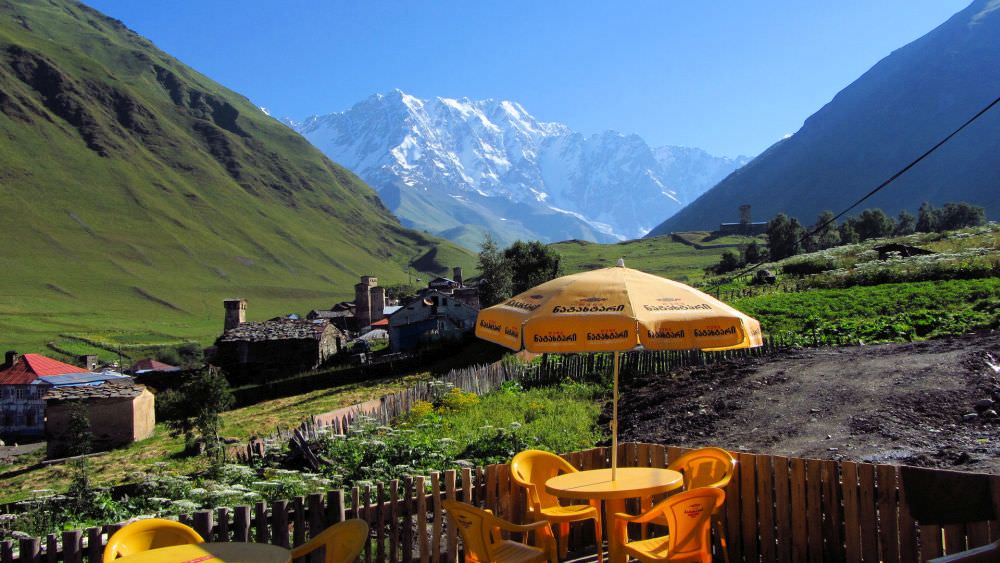
Thanks to Břetislav for his cool photo of Adishi glacier. Other photos were provided by Oriol Girona, Josef Formanek, Jozef Strezenec and me.
And the last, but not least - 4 photos were provided by Jordan Atkins.
More of his photos of Svaneti can be found at his web Inspired by Maps.


